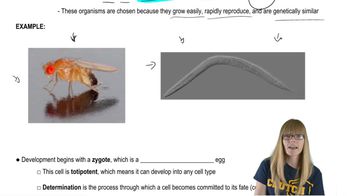How can the role of epigenetics in cancer be reconciled with the idea that cancer is caused by the accumulation of genetic mutations in tumor-suppressor genes and proto-oncogenes?
Table of contents
- 1. Introduction to Genetics51m
- 2. Mendel's Laws of Inheritance3h 37m
- 3. Extensions to Mendelian Inheritance2h 41m
- 4. Genetic Mapping and Linkage2h 28m
- 5. Genetics of Bacteria and Viruses1h 21m
- 6. Chromosomal Variation1h 48m
- 7. DNA and Chromosome Structure56m
- 8. DNA Replication1h 10m
- 9. Mitosis and Meiosis1h 34m
- 10. Transcription1h 0m
- 11. Translation58m
- 12. Gene Regulation in Prokaryotes1h 19m
- 13. Gene Regulation in Eukaryotes44m
- 14. Genetic Control of Development44m
- 15. Genomes and Genomics1h 50m
- 16. Transposable Elements47m
- 17. Mutation, Repair, and Recombination1h 6m
- 18. Molecular Genetic Tools19m
- 19. Cancer Genetics29m
- 20. Quantitative Genetics1h 26m
- 21. Population Genetics50m
- 22. Evolutionary Genetics29m
13. Gene Regulation in Eukaryotes
Epigenetics, Chromatin Modifications, and Regulation
Problem 19a
Textbook Question
A developmental disorder in humans called spina bifida is a neural tube defect linked to a maternal diet low in folate during pregnancy.
What does this suggest about the cause of spina bifida?
 Verified step by step guidance
Verified step by step guidance1
Understand the role of folate in human development: Folate is a vital nutrient required for DNA synthesis, repair, and methylation, processes that are crucial during rapid cell division and tissue formation in early embryonic development.
Recognize the importance of the neural tube: The neural tube is the embryonic structure that develops into the brain and spinal cord. Proper closure of the neural tube is essential for normal development, and defects in this process can lead to conditions like spina bifida.
Connect folate deficiency to neural tube defects: A maternal diet low in folate can impair DNA synthesis and cell division, potentially disrupting the closure of the neural tube during early pregnancy, leading to spina bifida.
Consider the timing of folate intake: Neural tube closure occurs very early in pregnancy, often before a woman knows she is pregnant. This highlights the importance of adequate folate intake before and during early pregnancy.
Conclude the cause: Spina bifida is likely caused by a combination of genetic predisposition and environmental factors, such as insufficient maternal folate intake during critical periods of embryonic development.
 Verified video answer for a similar problem:
Verified video answer for a similar problem:This video solution was recommended by our tutors as helpful for the problem above
Video duration:
1mPlay a video:
Was this helpful?
Key Concepts
Here are the essential concepts you must grasp in order to answer the question correctly.
Neural Tube Defects
Neural tube defects (NTDs) are serious birth defects that occur when the neural tube, which forms the brain and spinal cord, does not close completely during early fetal development. Spina bifida is one of the most common NTDs, characterized by the incomplete closure of the spinal column, leading to various physical and neurological challenges. Understanding NTDs is crucial for recognizing the importance of early prenatal care and nutrition.
Recommended video:
Guided course

Other Gene Interactions
Folate and Its Role in Development
Folate, also known as vitamin B9, is essential for DNA synthesis, repair, and methylation, making it critical for cell division and growth during pregnancy. A deficiency in folate can disrupt normal neural tube development, increasing the risk of defects like spina bifida. This highlights the importance of adequate maternal nutrition before and during pregnancy to support fetal health.
Recommended video:
Guided course

Genetics of Development
Maternal Nutrition and Birth Outcomes
Maternal nutrition significantly influences fetal development and can affect birth outcomes. A diet lacking in essential nutrients, such as folate, can lead to developmental disorders, including spina bifida. This concept underscores the need for healthcare providers to educate expectant mothers about the importance of a balanced diet rich in vitamins and minerals to promote healthy pregnancies.
Recommended video:
Guided course

Maternal Effect
Related Videos
Related Practice
Textbook Question
452
views


